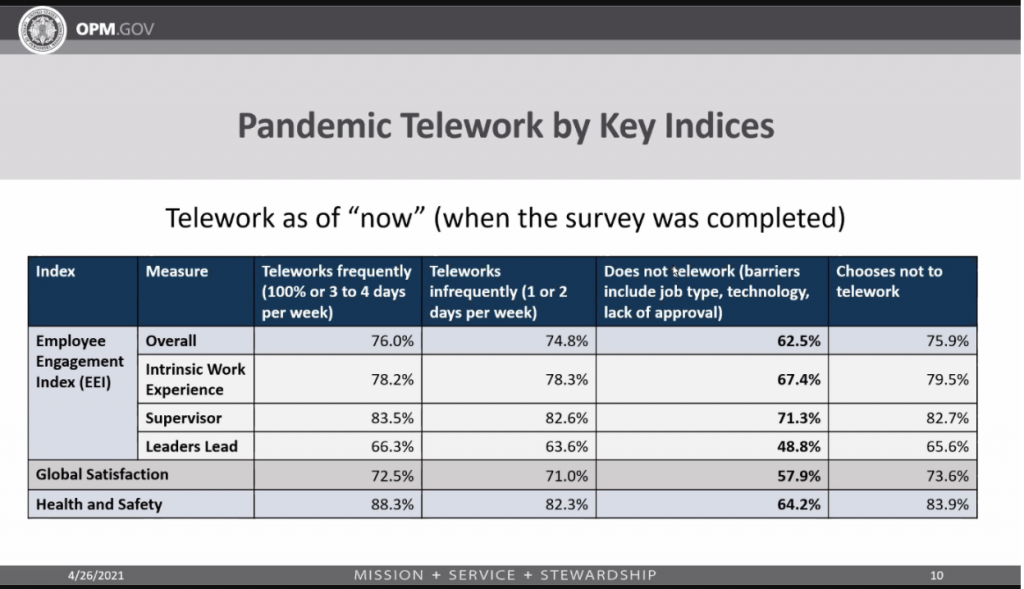We’ve known for decades that employees who can take advantage of workplace flexibilities such as telework tend to be more engaged. Add to that mix impactful work in the midst of a global pandemic and supervisors who support employee health and safety, and you might begin to understand what’s driving increased engagement across the federal workforce. 
According to the latest Federal Employee Viewpoint Survey (FEVS), an annual snapshot of how employees view their current work environment, overall engagement governmentwide rose from 68% in 2019 to 72% in 2020. Yes, you read that correctly. And there was a marked difference in engagement between teleworkers and those who could not work remotely, which we’ll dive into later.
“Decades of telework research show that there is a strong link between things like telework participation and employee engagement scores,” said Kimberly Wells, Manager, Survey Analysis, at the Office of Personnel Management (OPM).
Wells, who has an extensive background in organizational change for workplace effectiveness and oversees the survey analysis group that conducts the FEVS, unpacked the results this week during a roundtable with reporters.
One of our big takeaways from the survey is that federal employees are at their best when they can engage in mission-oriented work — even in the most extreme conditions — but do so in a workplace environment that’s designed to support their well-being.
“Federal employees reported that a key driver of workforce resilience came from front-line supervisors taking an active role in supporting their employees, especially regarding health, safety, and work-life needs,” OPM said in a statement about the results.
As agency leaders reimagine what the future of work will entail, they cannot afford to understate the value of making workplace flexibilities a hallmark of those efforts through policies and other mechanisms. This is true whether they’re considering hybrid workforces or permanently reclassifying positions that previously did not qualify for telework.
“Prior to the pandemic, only 3% of employees teleworked daily, but that number grew substantially during the peak of the pandemic when a record 59% of employees teleworked every day,” according to the survey. Currently, about 47% of the federal workforce is teleworking, but it’s unclear how those numbers will evolve going forward.
Before the pandemic, 24% said they did not telework because they had to be physically present at their jobs. Think border patrol and security personnel. That number dropped to 16% during the peak of the pandemic and is now at 18%.
We asked OPM what types of workplace flexibilities the administration is looking to implement or expand. We were told that OPM is working internally and with other agencies to develop updated teleworking guidance, with more details coming soon.
What will be telling, however, is the extent to which employee feedback drives change. Only 43% of the workforce believes the FEVS results will be used to make their agency a better place to work.
Let’s quickly revisit the basics by breaking down that increased engagement score we mentioned earlier. The engagement index is based on specific questions that “assess the critical conditions conducive for employee engagement,” such as effective leadership, meaningful work and opportunities to learn and grow.
New this year was a section dedicated to measuring how the pandemic affected employees’ work. This led to one of the most significant revisions in the survey’s history over the past two decades, which included streamlining standard questions to make room for the pandemic section.
Although many items, including the engagement index, were retained, OPM advises that “interpretation of any score changes between 2020 and prior years must be made very cautiously.”
On the surface, federal employees had every reason to feel uninspired when this survey was conducted between September and November 2020. The coronavirus was ravaging nations and families and political tensions in the U.S. were extremely high. You may be wondering if survey participation decreased. Well, it actually went up a percentage point (44%), up from 43% in 2019 and 41% in 2018.
During the reporter roundtable, Wells was specifically asked why the scores don’t seem to reflect what many have called former President Trump’s policy “assault” and “attacks” on the civil service.
“Initially, I have to say I did have the staff to pull down the data again and clean it all over again because I found it interesting that, even apart from the Trump administration, or any other administration, just this notion that we’re in the middle of a pandemic, and to see these scores come up, to me, is quite surprising,” Wells said.
She made clear that the survey does not measure whether employees feel that an administration likes them or not. But what it does measure — and what the most recent numbers clearly showed — is that federal employees are resilient.
Here’s what the numbers tell us about employee resilience. Nearly a quarter of respondents said that the pandemic had been extremely or very disruptive to their ability to get their work done, Wells said. And 48% said that their work demands have either greatly or somewhat increased.
Despite battling higher workloads and disruption to their work, employee confidence in their work unit’s performance remained high. This measures things like the ability to continue producing high-quality work and meeting customers’ needs. Wells acknowledged that it took a slight dip, compared with pre-COVID-19 numbers, but was still high.
“That really speaks, we think, a lot to the resilience of the workplace,” she said.
We promised to dig into the telework numbers a little more, so let’s get to it.
Wells noted two things that had a direct impact on employee engagement scores: telework and leadership support of employees’ health and safety. She shared a chart that breaks down engagement and satisfaction by telework status (See Figure 1).
On the left side, you’ll see the different indices. We discussed the employee engagement index earlier. Global satisfaction encompasses questions that measure employees’ satisfaction with their jobs, their pay, and their organization, plus their willingness to recommend their organization as a good place to work.
Health and safety, which is a new index, measures the extent to which employees feel their leaders prioritized their health and safety.
When you dig further and compare engagement between those who’ve been able to telework during the COVID-19 pandemic (76%) and those who could not (62.5%), due to barriers such as job type, technology and lack of approval, there’s a stark contrast (See Table 1).

Figure 1 (Source: Office of Personnel Management)
In the chart, you can also see a wide gap in sentiments around employee health and safety being prioritized, depending on employees’ telework status.
Wells emphasized the critical role that managers played in not only extending telework options to employees, many of whom also balanced virtual school and care for loved ones, but also considering all workplace flexibilities. That included work schedule shifting, perhaps working evening hours and being creative in terms of how employees could meet personal requirements and still fulfill their mission duties.
“It’s a fairly unusual and a very new addition to the value proposition within [the] federal government in most organizations at this point, is that we are prioritizing equally, not just employee performance, but employee health and safety — putting them on par,” Wells said. “And so I think that’s a powerful, powerful message that we’ve seen time and again in the research that will support things like improved engagement scores and satisfaction scores, improvements across the board.”





Leave a Reply
You must be logged in to post a comment.